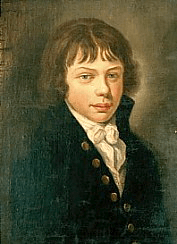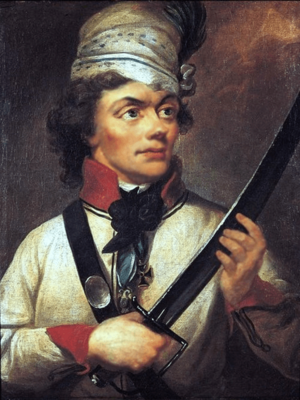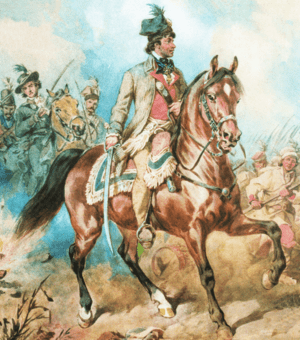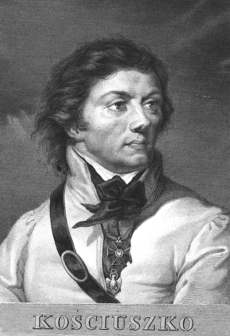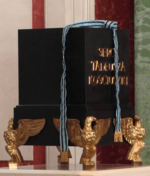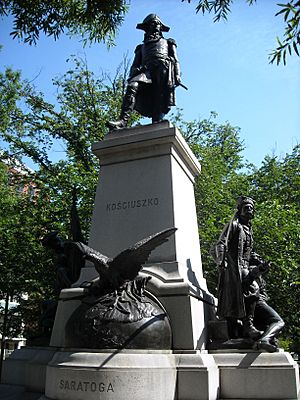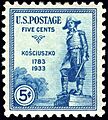Tadeusz Kościuszko facts for kids
Quick facts for kids
Tadeusz Kościuszko
|
|
|---|---|

Portrait by Karl Gottlieb Schweikart. Kościuszko is shown wearing the Eagle of the Society of the Cincinnati, awarded to him by General Washington.
 Coat of arms: Roch III |
|
| Birth name | Andrzej Tadeusz Bonawentura Kościuszko |
| Born | 4 February 1746 Mereczowszczyzna, Polish–Lithuanian Commonwealth |
| Died | 15 October 1817 (aged 71) Solothurn, Switzerland |
| Allegiance |
|
| Service/ |
|
| Years of service | 1765–1794 |
| Rank |
|
| Unit |
|
| Battles/wars |
|
| Awards |
|
| Signature | |
Tadeusz Kościuszko (born February 4 or 12, 1746 – died October 15, 1817) was a famous military engineer and leader. He is considered a national hero in many countries, including Poland, the United States, Belarus, Lithuania, and France. Kościuszko fought for freedom in the American Revolutionary War and led an uprising in Poland against Russia and Prussia.
He was born in a manor house in Mereczowszczyzna, which was then part of the Polish-Lithuanian Commonwealth. At 20, he finished military school in Warsaw. After a civil war started in Poland, he went to France in 1769 to study more. In 1776, Kościuszko moved to North America. He joined the Continental Army as a colonel and became a skilled military architect. He designed and built strong forts, including the famous ones at West Point. For his great work, he was made a brigadier general in 1783.
Kościuszko returned to Poland in 1784 and became a major general in the Polish army. After Poland lost a war against Russia in 1792, he led an uprising in 1794. He was captured in battle, and the uprising failed. This led to Poland being divided among other countries, ending its independence for over 100 years. In 1796, he was freed and moved to the United States. He was a close friend of Thomas Jefferson and believed strongly in human rights. Kościuszko wrote a will to use his money to help educate and free enslaved people in the U.S. He later returned to Europe and lived in Switzerland until he died in 1817.
Contents
Early Life and Education
Tadeusz Kościuszko was born in February 1746. His family lived on the Mereczowszczyzna estate in the Polish-Lithuanian Commonwealth. His exact birthday is not known, but it was either February 4 or 12.
He was the youngest son of Ludwik Tadeusz Kościuszko, a Polish army officer. His family was part of the Szlachta, which was the Polish nobility. They had a modest amount of land and some peasant families working for them.
Tadeusz was baptized in the Catholic faith. His family had roots in Lithuania and Ruthenia. They had become more Polish over time, speaking Polish and following Polish culture.
In 1755, Kościuszko started school in Lubieszów. However, he had to leave early because his family faced money problems after his father died in 1758.
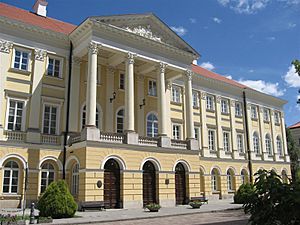
In 1765, the King of Poland, Stanisław August Poniatowski, opened a new military school called the Corps of Cadets. Kościuszko joined this school. It taught military subjects and other important skills. He graduated in 1766 and became a chorąży, a rank similar to a modern lieutenant. By 1768, he was a captain.
Studying in Europe
In 1768, a civil war began in Poland. Kościuszko decided to leave the country. In late 1769, he received a scholarship and traveled to Paris, France. He wanted to continue his military studies.
Since he was a foreigner, he could not join French military academies. Instead, he enrolled in the Royal Academy of Painting and Sculpture. There, he studied drawing and painting. He also took private lessons in architecture.
Kościuszko spent five years in Paris. He learned a lot about military strategy and visited military libraries. He was greatly influenced by the French Enlightenment. This time helped shape his ideas about freedom and human rights. He also improved his artistic skills, which he used throughout his life.
In 1772, Russia, Prussia, and Austria divided parts of Poland among themselves. This event is known as the First Partition of Poland. When Kościuszko returned home in 1774, he found that his family's money was mostly gone. He could not afford to buy a position in the army.
He became a tutor for a wealthy family. He fell in love with the governor's daughter, Ludwika. Their plan to run away together was stopped by her father's guards. This event made Kościuszko dislike the idea of social classes.
In 1775, he left Poland to avoid Ludwika's family. He tried to join the Saxon army but was not accepted. He then decided to return to Paris. There, he heard about the American Revolutionary War. The American colonies were fighting for their freedom from Britain. Kościuszko, who believed in revolution, decided to go to America.
Fighting for American Freedom
Kościuszko believed in the American cause and human rights. In June 1776, he sailed to America. On August 30, 1776, he applied to the Second Continental Congress. The next day, he joined the Continental Army.
Building Forts in the North
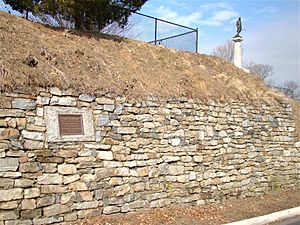
Kościuszko's first job was to build forts at Fort Billingsport in New Jersey. These forts would protect the Delaware River from British ships. On October 18, 1776, he was made a colonel of engineers in the Continental Army.
In 1777, Kościuszko was sent to the Northern Army. He went to Fort Ticonderoga, a very important fortress. He suggested building a battery (a place for cannons) on a high hill called Sugar Loaf. This hill overlooked the fort. However, the commander did not listen to his advice.
This was a big mistake. When the British army arrived, they put their cannons on Sugar Loaf, just as Kościuszko had warned. The Americans realized they could not win and left the fort without a fight.
As the Americans retreated, Kościuszko was ordered to slow down the British. He used his engineering skills to cut down trees, block streams, and destroy bridges. This made it very hard for the British to move their large supply wagons. It gave the Americans time to safely cross the Hudson River.
Kościuszko then found a strong defensive position near Saratoga. He designed and built strong defenses there. His careful work helped the Americans win the Battle of Saratoga. This victory was a major turning point in the war. General Horatio Gates praised Kościuszko, saying that "hills and forests, which a young Polish engineer was skillful enough to select for my encampment," were key to the victory.
In 1778, Kościuszko went to West Point, New York. He spent over two years making the fortifications even stronger. These defenses were so good that when American General Benedict Arnold later tried to betray West Point to the British, he failed.
Serving in the South
In 1780, Kościuszko moved south to join the Southern Army. He became the chief engineer for Major General Nathanael Greene. Both General Gates and General Greene highly praised his work.
Kościuszko's tasks included building boats, finding good places for camps, scouting river crossings, and building defenses. His work was very important in keeping the Southern Army safe. For example, during the "Race to the Dan" in 1781, he helped the American army cross several rivers safely. This stopped the British army from catching them.
Kościuszko also helped choose the site for the Battle of Guilford Court House. Even though the Americans lost the battle, they badly damaged the British army. This gave the Americans a big advantage in the South.
He later helped fortify American bases in North Carolina. He also took part in smaller battles, fighting British groups near Charleston, South Carolina. His last battle of the war was on November 14, 1782, at James Island, South Carolina. A month later, he was among the troops who took back Charleston from the British.
Returning Home
Kościuszko had not been paid for his seven years of service. In 1783, he tried to get his salary. Congress promoted him to brigadier general on October 13, 1783. He still had to wait for his pay. He borrowed money from a banker named Haym Salomon. Eventually, he received a certificate for $12,280 and the right to 500 acres of land if he settled in the U.S. He was also welcomed into the Society of the Cincinnati.
He carried an old Spanish sword with a special message: "Do not draw me without reason; do not sheathe me without honour."
Back in Poland
On July 15, 1784, Kościuszko left for Poland. He arrived on August 26. He could not get a job in the Polish army right away. He settled on his family's land. His brother had lost most of their family's money. Kościuszko decided to reduce the amount of work his peasants had to do for him. This made his estate less profitable, and he started to go into debt.
He became friends with people who wanted to reform Poland. In 1789, he finally received a royal commission as a major general in the Polish army. This ended his money problems. He started receiving a high salary.
Kościuszko became more involved with political reformers. He believed that peasants and Jewish people should have full citizenship rights. This would make them want to defend Poland more. In 1791, Poland adopted a new constitution. Kościuszko thought it was a good step, but he was disappointed that it did not do enough for peasants and Jewish people.
Poland's neighbors saw the new constitution as a threat. In May 1792, a large Russian army crossed the Polish border. This started the Polish–Russian War of 1792.
Defending the Constitution
The Russian army was much larger and more experienced than the Polish army. Kościuszko was made a division commander. He suggested that the Polish army should gather all its forces to fight one Russian army. This would give them a better chance to win. However, his plan was not accepted.
The Polish army had to retreat. Kościuszko commanded the rear guard, protecting the main army. On June 18, the Poles won the Battle of Zieleńce. Kościuszko was awarded the Virtuti Militari, Poland's highest military award.
On July 18, 1792, Kościuszko fought the Battle of Dubienka. With only about 5,300 men, he defeated 25,000 Russians. He used the land and his forts very skillfully. Even though it was a victory, he had to retreat because the Russians went around his position.
After the battle, King Stanisław August Poniatowski promoted Kościuszko to lieutenant-general. He also offered him a royal award, but Kościuszko, who believed in a republic, refused it. News of his victory spread across Europe. On August 26, he was made an honorary citizen of France.
However, the King of Poland decided to surrender to Russia. Kościuszko was very upset. He resigned from the army on August 30.
Life as an Émigré
The King's surrender was a hard blow for Kościuszko. He had not lost a single battle. In September 1792, he decided to leave Poland. He traveled to Leipzig, where many Polish soldiers and politicians who opposed Russian rule had gathered.
Kościuszko and others began planning an uprising against Russia. In January 1793, he went to Paris to try and get France's support. However, the French government was not very interested in helping Poland. They were focused on their own revolution. Kościuszko was disappointed by the fighting among French groups and the growing "Reign of Terror."
On January 23, 1793, Prussia and Russia signed the Second Partition of Poland. Poland became a much smaller country. This shocked many Poles, even those who had supported Russia.
In August 1793, Kościuszko returned to Leipzig. He was pressured to start the uprising soon. In September, he secretly went back to Poland to meet with Polish officers. The preparations were slow. He left for Italy, planning to return in February 1794.
But the situation in Poland changed quickly. Russia and Prussia forced Poland to reduce its army even more. Russian agents also started arresting Polish leaders. Kościuszko had to start his plan earlier than expected. On March 15, 1794, he left for Kraków.
Kościuszko Uprising
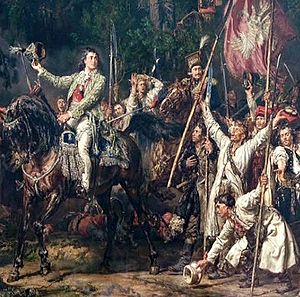
On March 23, 1794, Kościuszko entered Kraków. The next morning, he announced the start of an uprising. He was named Naczelnik (commander-in-chief) of the Polish forces fighting Russia.
Kościuszko gathered an army of about 6,000 men. He marched towards Warsaw. He won a victory at Racławice on April 4, 1794. He personally led a charge of peasant volunteers armed with scythes. However, this victory was not enough to stop the Russians.
Kościuszko had to retreat. He received more soldiers and met with other uprising leaders. He issued the Proclamation of Połaniec. This declaration gave civil rights to serfs (peasants tied to the land) and reduced their work duties. Meanwhile, the Russians offered a reward for Kościuszko's capture, "dead or alive."
By June, the Prussians joined the Russians. On June 6, 1794, Kościuszko fought a defensive battle against them at Szczekociny. For several weeks, he defended Warsaw, which was controlled by the rebels. He strongly spoke out against violence by a mob in Warsaw.
On October 10, during a battle at Maciejowice, Kościuszko was wounded and captured. He was imprisoned by the Russians in the Peter and Paul Fortress in Saint Petersburg. Soon after, the uprising ended. This led to the Third Partition of Poland, and Poland lost its independence for 123 years.
Later Life and Legacy
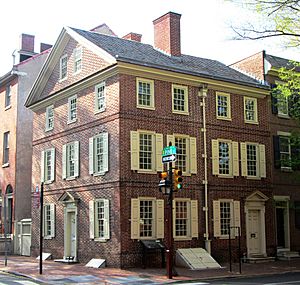
After the death of Empress Catherine the Great in 1796, Russia's policies changed. On November 28, Tsar Paul I pardoned Kościuszko and set him free. Paul also promised to free other Polish prisoners. The Tsar gave Kościuszko money, which Kościuszko later tried to return.
Kościuszko left for the United States, arriving in Philadelphia on August 18, 1797. People welcomed him, but the U.S. government was suspicious of him.
In March 1798, Kościuszko received news that Polish soldiers were fighting in France under Napoleon Bonaparte. He also learned that his nephews had joined Napoleon's army. This made him want to return to Europe.
He talked with Thomas Jefferson, who was then the Vice President. Jefferson helped him get a passport under a false name and leave secretly for France. Kościuszko and Jefferson were close friends. Jefferson called him "as pure a son of liberty as I have ever known."
Kościuszko's Will and Enslaved People
Before leaving for France, Kościuszko wrote a will. He left his American money to be used to buy the freedom of enslaved black people, including some of Jefferson's own. He also wanted the money to educate them for independent lives.
After Kościuszko died, Jefferson, who was very old, could not carry out the will. The money was never used for its intended purpose. However, its legacy led to the founding of an educational institute for African Americans in Newark, New Jersey, in 1826. It was named after Kościuszko.
Return to Europe and Final Years
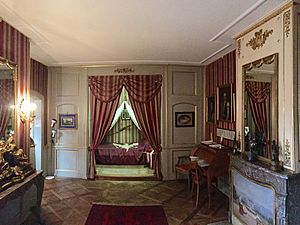
Kościuszko arrived in France in June 1798. He remained active in Polish groups there. He met with Napoleon Bonaparte but could not agree with him. Kościuszko did not like Napoleon's desire for total power.
He did not believe Napoleon would truly restore Poland's independence. When Napoleon created the Grand Duchy of Warsaw in 1807, Kościuszko did not join its army. He believed it was just a temporary solution.
After Napoleon's fall, Kościuszko met with Russia's Tsar Alexander I. The Tsar wanted Kościuszko to return to Poland. Kościuszko asked for social reforms and more territory for Poland. However, the new Polish state created by the Tsar was much smaller than Kościuszko wanted. He called it "a joke."
On April 2, 1817, Kościuszko tried to free the peasants on his remaining lands in Poland, but the Tsar did not allow it. Kościuszko died in Solothurn, Switzerland, on October 15, 1817, at age 71, after falling from a horse.
Funerals and Burial
Kościuszko's first funeral was held in Solothurn, Switzerland. News of his death spread, and memorial services were held across Poland. His body was later moved to Kraków, Poland, in 1818. On June 22, 1818, or June 23, 1819, his body was placed in a crypt at Wawel Cathedral. This is a special burial place for Polish kings and national heroes.
Kościuszko's internal organs were removed during embalming. They were buried separately in a graveyard near Solothurn. His heart was kept in an urn at the Polish Museum in Switzerland. In 1927, his heart was brought back to Warsaw, where it is now kept in a chapel at the Royal Castle.
Memorials and Tributes
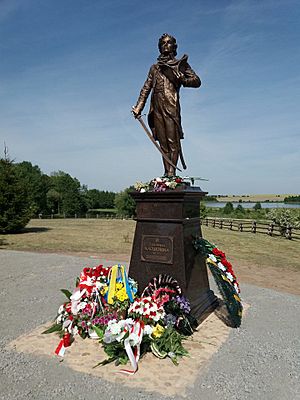
Tadeusz Kościuszko is honored as a national hero in Poland, the United States, Belarus, and Lithuania.
Many monuments around the world honor him. The Kościuszko Mound in Kraków, Poland, was built by people bringing earth from his battlefields. Bridges in New York, like the Thaddeus Kosciusko Bridge and the Kosciuszko Bridge, are named after him.
His former home in Philadelphia is now the Thaddeus Kosciuszko National Memorial, a small national park. There is also a Kościuszko Museum in Solothurn, Switzerland, where he died. The Kosciuszko Foundation in New York City promotes Polish-American culture.
Several Polish military units have been named after him, including air force squadrons and an infantry division. A Polish Navy ship also bore his name.
Kościuszko has been featured in many books, plays, and operas. The historical novel Thaddeus of Warsaw was very popular in the 19th century. Poets like Samuel Taylor Coleridge and John Keats wrote about him.
In 1933, the U.S. Post Office issued a stamp with his image. Poland has also issued stamps in his honor. A copy of his monument in Washington, D.C., was unveiled in Warsaw in 2010.
Statues of Kościuszko can be found in many cities, including Kraków, Warsaw, Boston, West Point, Philadelphia, and Washington, D.C. He has also been the subject of many paintings.
Geographic places named after him include Mount Kosciuszko, the tallest mountain in mainland Australia. There is also Kosciuszko National Park in Australia. Other places like islands, counties, cities, and streets in the United States bear his name.
Many biographies have been written about Kościuszko. The first one was by Julian Ursyn Niemcewicz, who was his aide and fellow prisoner.
Images for kids
-
Polish postage stamp (1938): Kościuszko with saber (left), Thomas Paine and George Washington.
-
Tadeusz Kościuszko Monument, Chicago
-
Mount Kosciuszko, mainland Australia's highest summit
See also
 In Spanish: Tadeusz Kościuszko para niños
In Spanish: Tadeusz Kościuszko para niños
- Kazimierz Pułaski (Anglicized as "Casimir Pulaski"), similarly honored Polish commander in the American Revolutionary War
- Michael Kovats de Fabriczy, Polish commander in the American Revolutionary War, known as "the father of the American cavalry"
- Brigadier General Thaddeus Kosciuszko – a monument in Washington, D.C.
- List of Poles
- Camp Kosciuszko


